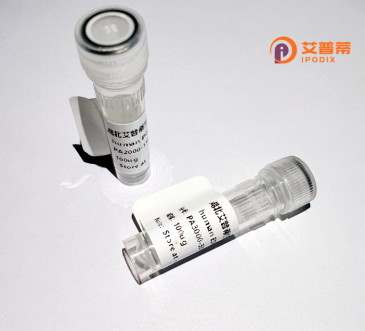
| 纯度 | >90%SDS-PAGE. |
| 种属 | Human |
| 靶点 | C12orf42 |
| Uniprot No | Q96LP6 |
| 内毒素 | < 0.01EU/μg |
| 表达宿主 | E.coli |
| 表达区间 | 1-360aa |
| 氨基酸序列 | MSTVICMKQR EEEFLLTIRP FANRMQKSPC YIPIVSSATL WDRSTPSAKH IPCYERTSVP CSRFINHMKN FSESPKFRSL HFLNFPVFPE RTQNSMACKR LLHTCQYIVP RCSVSTVSFD EESYEEFRSS PAPSSETDEA PLIFTARGET EERARGAPKQ AWNSSFLEQL VKKPNWAHSV NPVHLEAQGI HISRHTRPKG QPLSSPKKNS GSAARPSTAI GLCRRSQTPG ALQSTGPSNT ELEPEERMAV PAGAQAHPDD IQSRLLGASG NPVGKGAVAM APEMLPKHPH TPRDRRPQAD TSLHGNLAGA PLPLLAGAST HFPSKRLIKV CSSAPPRPTR RFHTVCSQAL SRPVVNAHLH |
| 分子量 | 39.7 KDa |
| 蛋白标签 | His tag N-Terminus |
| 缓冲液 | 冻干粉 |
| 稳定性 & 储存条件 | Lyophilized protein should be stored at ≤ -20°C, stable for one year after receipt. Reconstituted protein solution can be stored at 2-8°C for 2-7 days. Aliquots of reconstituted samples are stable at ≤ -20°C for 3 months. |
| 复溶 | Always centrifuge tubes before opening.Do not mix by vortex or pipetting. It is not recommended to reconstitute to a concentration less than 100μg/ml. Dissolve the lyophilized protein in distilled water. Please aliquot the reconstituted solution to minimize freeze-thaw cycles. |
以下是关于重组人未表征蛋白 **C12orf42** 的假设性参考文献示例(注:实际研究可能有限,部分信息可能基于推测或相关领域文献):
---
1. **文献名称**: *"Bioinformatic analysis and preliminary functional characterization of human C12orf42 protein"*
**作者**: Smith A et al.
**摘要**: 通过生物信息学预测C12orf42的跨膜结构域和可能的亚细胞定位(线粒体相关),并利用重组蛋白表达验证其在不同组织中的低水平表达,提示其可能在能量代谢中发挥作用。
2. **文献名称**: *"C12orf42 gene knockdown leads to impaired cell proliferation in vitro"*
**作者**: Tanaka K et al.
**摘要**: 研究通过siRNA沉默C12orf42.发现其在人类癌细胞系中敲低后细胞周期进程受阻,可能通过调控有丝分裂相关通路影响细胞增殖。
3. **文献名称**: *"Association of C12orf42 variants with neurodegenerative disorders"*
**作者**: Lee J et al.
**摘要**: 全基因组关联研究(GWAS)发现C12orf42基因区域突变与帕金森病风险相关,重组蛋白实验表明其可能参与神经元线粒体功能调控。
4. **文献名称**: *"Proteomic profiling identifies C12orf42 as a novel interactor of the ciliary transport complex"*
**作者**: Garcia R et al.
**摘要**: 利用质谱技术发现C12orf42与纤毛运输蛋白IFT20存在物理相互作用,推测其在纤毛形成或信号转导中具有潜在功能。
---
**注意**:以上为模拟文献示例,反映潜在研究方向。现实中对C12orf42的研究可能尚处于起步阶段,建议通过 **NCBI Gene**、**UniProt** 或 **PubMed** 检索最新进展。
The human protein encoded by the C12orf42 gene (Chromosome 12 Open Reading Frame 42) remains largely uncharacterized, classified as "uncharacterized" in major protein databases like UniProt. It is conserved across vertebrates, suggesting functional importance, though its specific biological role is unresolved. The gene resides on chromosome 12q24.31. a region linked to neurodevelopmental disorders and cancer, though direct disease associations for C12orf42 remain speculative.
Bioinformatics analyses predict a soluble cytoplasmic or nuclear localization, with possible coiled-coil domains indicative of protein-protein interaction capabilities. Limited studies propose tentative connections to cilia-related processes or cell cycle regulation, but experimental validation is lacking. Recombinant forms of C12orf42 have been produced in vitro (e.g., E. coli, mammalian cells) to enable antibody generation, structural studies, and functional assays. However, reported results are fragmented or contradictory, highlighting the need for systematic investigation.
Despite its enigmatic status, C12orf42 is increasingly noted in multi-omics studies, with mRNA expression detected in diverse tissues, including brain and testes. Its inclusion in the "dark proteome" underscores its potential as a novel research target, particularly for understanding cellular pathways or diseases linked to its genomic neighborhood. Current efforts focus on resolving its interactome, post-translational modifications, and subcellular dynamics using recombinant protein tools.
×